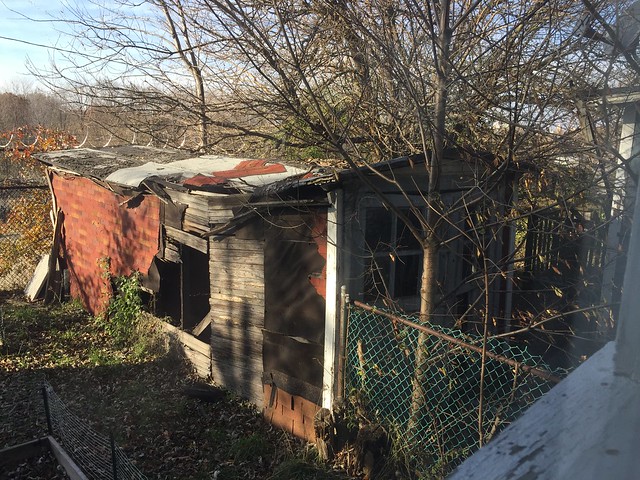Is there anything wrong with using asphalt composition shingles for siding as inquiring minds want to know (ok me).
Yes, me too… good one:)
They look like Cra-p and it seems they always are pulling off from vertical or missing .
If the flashing is there and no leaks are present, I think I would at still write it up as a non-standard “siding” application.
I would rather have facts to back that up.
Yes does have separation and metal flashing
No not leaking from what I can tell though that is part of a valley that hits the chimney and that is an issue.
Similar to ghetto brick which was used during the mid 1900’s.
A architectural shingle could have some nice dimensional shadows as siding but I would think it would be difficult to seal at the vertical trims.
More on asphalt shingle siding:

This is a site dedicated to preserving, in photo’s, a unique building material that is slowly fading away.
Not much difference between this and a Gambrel (like a barn) style roofs(lower portions). I’ve seen this a few times in just this type of application. I usually mention it to the client but don’t write it up.
Nothing in recommend against them though eh.
I am wondering what the pitfalls of using asphalt siding as vertical wall covering really are.?
In Chicago we plenty of that stuff that is asphalt siding, but made to be siding.
I think it is called insulbrick.
Ok I just found in my old Carson Dunlop book that when used as siding they have a tendency to curl or lift as the sun softens the adhesive put on by the factory.
They are then prone to wind damage.
.
Hmmmm
Guess that explains a lot.
Thanks Larry.
Never heard it called Ghetto Brick before.
When the roof leaks, you figure it out sooner or later. If the WALL is leaking, it could do significant structural damage to multiple levels without tell-tell signs for quite some time.
Plus, most wall siding applications last longer than 12 years.
Comp shingles depend heavily on proper bonding of the adhesive strip to develop wind resistance to their full potential. Key to the development of a proper bond is the weight of the shingle pressing the shingles together while the adhesive is soft.
When the shingle hangs vertically, this weight is lacking and the chances are good that the bond will be inadequate. Most manufacturers require hand-sealing of shingles on roofs steeper than 21&12.
The poorer the quality of the asphalt forming the adhesive strip, the less likely that a satisfactory bond will form on a vertical surface.
Thanks everyone, as it is good to have the facts.
Somehow just clicking “loose” on a report leaves me unsatisfied. 
Okay Linus,
We’re all waiting for one of your witty comebacks… :p:twisted:![]()
I see it used on A Frames all of the time. I also see it on mansards.
Speaking on behalf of Linas, I believe ‘loose as a goose’ would have been brought to light. ![]()
[quote=“lkage, post:6, topic:40873”]
Similar to ghetto brick which was used during the mid 1900’s.
Used to have that same material on my Father’s House Larry, great product, and lasted for years until he covered it up with asbestos siding. Then it look exellent. Durable material. Don’t know what’s on there now, haven’t seen it in over 30 years. :mrgreen:
:lol::lol::lol::lol:
Marcel has it! Asphalt shingles as siding go back at least to the late 1920s. In those days there were no self sealing strips. They seemed to last a lot longer than shingles on roofs. I think they had less total exposure to the weather. I did a wander through local neighborhoods a while back and found two houses with **old **asphalt shingle siding still in place.


